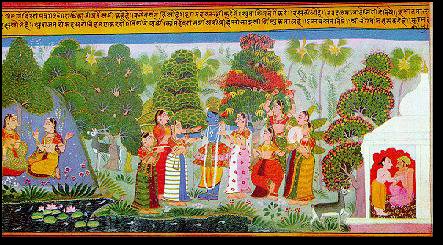Tweet

"Radhikaji... mrgamada kasturi Sri bhagavana nrtya kara rahe he... mrgamada."
The verse develops the theme of Krsna and his dance with the gopis, and His love play with them. All of nature with its scents and perfumes, flaming colors of flowers are summoned to convey the beauty and the charm of the dance. The air is filled with the strong scent of deer musk, the fresh tamala leaves absorb it. The palasa (the flame of the forest) with its spiked flowers is like the nails of love (nakha sikha), which tear at young hearts. Hari roams about in this vernal season and dances with young maidens.
While Radha and the sakhi sit in an exclusive corner on a slope, the refrain and the description of the Spring season is coalesced and not distinguished from one another. Now there are only two pictorial situations - not three. Faithful to the verse, the scent of the deer musk is suggested through two delightfully drawn deers. One is in the background and the other diagonally opposite in the foreground. The scent of the deer musk is evoked in the painting. Spike like flowers of the palasa (the flame of the forest), is transformed into a pictorial image. Here all trees and branches go up in flames. The nakha sikha (the nail marks of love) are as if distributed among the branches and the flowers. Although the palasa and its shape is not naturalistically presented, the poetic image is clearly conveyed.
Far off in Assam, in a contemporary Gita-Govinda set, we encounter the same sensitive comprehension of the verse in pictorial terms. The image is reinforced by placing Krsna in the center of the painting and many gopis touching him. The hands and the nails are precisely drawn. Another group of four gopis dance and sing. While one holds a jhanjha (large cymbals), another lifts her arms in ecstasy, and a third stands in a nupurapadika stance. The groups are beautifully balanced spatially. In a lower far corner sit Jayadeva and a devotee singing the song. The artist employs a rich vocabulary of formal elements to evoke an emotional state.
Many critics have commented on the treatment of nature in Indian miniature painting and the specific stylistic features of Mewari trees and foliage. However, perhaps few have noticed that although nature, trees, birds, and animals are stylised and not delineated naturalistically, they are not mere decorative mannerism. The variations and the range are determined by the poetry, being translated into picture. What the artist cannot convey through paint he does by a concrete image (e.g. the deer musk scent). A simile he cannot directly convey, he expresses through nature - particularly trees, creepers, sky, and the Jamuna. This set provides many splendid examples of this technique.
The palette and color scheme are also guided by the suggestions provided in the text. The tamala tree and its dark colors add to the vividness of the picture. The dominant colors of dark blue, red, green, and yellow are used with sensitivity. A discerning observer will immediately grasp the value of the colors used. The composition of the painting evokes a response of smell, sight and color, and touch - effectively through a known and shared associative memory. The forms are all perfectly and harmoniously balanced.

